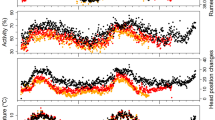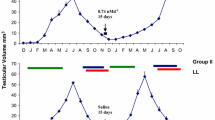Summary
Infradian cycles of body weight occur in captive dormice,Glis glis. The period of these cycles is often about 2 months but is highly variable both between and within individuals. These cycles can persist for at least 3 years. This paper describes a number of variables that change on an infradian basis along with body weight. These include: food and water intake, weight of the liver, adrenal and salivary gland weight, testes weight and spermatogenic condition, body temperature and wheel-running activity. Both the amount of running and its distribution over a 24 h period change. However, infradian cycles do not appear to be generated by the circadian system because they persist even in continuous bright light sufficiently intense to disrupt circadian organization. They also persist in LD 18∶6, LD 12∶12, LD 6∶18 and in naturally changing photoperiods. No evidence of photoperiodic effects on cycles was detected except that animals in long days have slightly higher moulting scores than those in short days. Moulting is more marked when body weight stays relatively stable. In dormice remaining stable in weight for several months testes have sperm present. The period of infradian cycles is temperature dependent: in a cool room animals that hibernate have longer cycles with periods varying from a few months to about a year. In a number of respects at least, infradian cycles appear to be accelerated circannual cycles. The adaptive value of a system that gives rise to infradian cycles probably relates to opportunism in an unpredictable environment. Infradian cycles in dormice may be a useful preparation for obtaining data on spontaneous physiological and behavioural changes in hibernators in less than a year.
Similar content being viewed by others
References
Agid, R., Ambid, L., Sable, R., Sicart, R.: Aspects of metabolic and endocrine changes in hibernation. In: Strategies in cold: natural torpidity and thermogenesis. Wang, L.C.H., Hudson, J.W. (eds.), pp. 499–540. New York: Academic Press 1978
Aschoff, J.: Survival value of diurnal rhythms. Symp. Zool. Soc. (London)13, 79–98 (1964)
Boshes, M.: An analysis of feeding behavior and feeding patterns in two species of hibernating rodents, the golden-mantled ground squirrel,Spermophilus lateralis and the edible dormouse,Glis glis. Ph.D. Thesis, University of Toronto (1978)
Brawer, J.R., Gustafson, A.W.: Changes in the fine structure of the tanycytes during the annual reproductive cycle of the male little brown batMyotis lucifugus lucifugus. Am. J. Anat.154, 497–508 (1979)
Butschke, H.W.: Investigations of circadian and circannian rhythms in field-caught and “Kaspar-Hauser” fat dormice (Glisglis L.) with self-selection experiments. J. Interdiscip. Cycle Res.8, 293–296 (1977)
Canguilhem, B., Schieber, J.-P., Koch, A.: Rythme circannuel pondéral du hamster d'europe (Cricetus cricetus). Influences respectives de la photopériode de la température externe sur son déroulement. Arch. Sci. Physiol.27, 67–90 (1973)
Contet-Audonneau, J.-L.: Contribution à l'étude, au cours du cycle annuel du Système hypothalamo-hypophysaire de l'épiphyse, des gonades et des surrénales chez deux mammifères hibernants: le muscardin et le loir. Thesis, University of Nancy (1975)
Ferguson, G.A.: Statistical analysis in psychology and education, pp. 239–242. New York: McGraw Hill 1966
Fischer, K., Butschke, H.-W., Mahlert, D.: Untersuchungen zur circadianen und circannualen Rhythmik bei Siebenschläfern (Glis glis L.) im Selbstwählversuch. Z. Säugetierkd.40, 65–74 (1975)
Fisher, K.C., Manery, J.F.: Water and electrolyte metabolism in heterotherms. In: Mammalian hibernation III. Fisher, K.C., Dawe, A.R., Lyman, C.P., Schönbaum, E., South, F.E. (eds.), pp. 235–279. Edinburgh, London: Oliver and Boyd 1967
Goss, R.J.: Photoperiodic control of antler cycles in deer I. Phase shift and frequency changes. J. Exp. Zool.170, 311–324 (1969)
Gwinner, E.: Circannual rhythms in birds: their interaction with circadian rhythms and environmental photoperiod. J. Reprod. Fertil. [Suppl.]19, 51–65 (1973)
Gwinner, E.: Photoperiod synchronization of circannual rhythms in the European starling (Sturnus vulgaris). Naturwissenschaften64, 44 (1977)
Haberey, P., Dantlo, C., Kayser, C.: Méthode d'éxploration du comportement alimentaire d'un hibernant, le LérotEliomys quercinus. C.R. Soc. Biol. (Paris)160, 655–659 (1966)
Hallonquist, J.D.: A comparison of normal and lateral hypothalamic electrically induced feeding in two hibernators,Citellus lateralis andGlis glis. Ph.D. Thesis, University of Toronto (1978)
Hallonquist, J.D., Mrosovsky, N.: Electrically induced and normal feeding: different controls in the dormouse. Physiol. Behav.23, 357–362 (1979)
Hudson, J.W., Wang, L.C.H.: Hibernation: endocrinologic aspects. Annu. Rev. Physiol.41, 287–303 (1979)
Joy, J., Melnyk, R.B., Mrosovsky, N.: Reproductive cycles in the male dormouse (Glis glis). Comp. Biochem. Physiol., (in press)
Kayser, C.: The physiology of natural hibernation. Oxford: Pergamon Press 1961
König, C.: Einflüsse von Licht und Temperatur auf den Winterschlaf des SiebenschläfersGlis g. glis (Linnaeus 1766). Z. Morphol. Ökol. Tiere48, 545–575 (1960)
Koenig, L.: Das Aktionssystem des Siebenschläfers (Glis glis L.). Z. Tierpsychol.17, 427–505 (1960)
Lacey, O.L.: A revised procedure for the calibration of the activitywheel. Am. J. Psychol.57, 412–420 (1944)
Laufens, G.: Beginn und Ende der täglichen Aktivität freilebender Haselmäuse (Muscardinus avellanarius L.) und Siebenschläfer (Glis glis L.). Z. Säugetierkd.40, 74–89 (1975)
Lockard, R.B.: Experimental inhibition of activity of kangaroo rats in the natural habitat by an artificial moon. J. Comp. Physiol. Psychol.89, 263–266 (1975)
McKeever, S.: The biology of the golden-mantled ground squirrel,Citellus lateralis. Ecol. Monogr.34, 383–401 (1964)
Melnyk, R.B.: Pancreatic islet changes accompanying body weight cycles in the dormouse. M.A. Thesis, University of Toronto (1976)
Melnyk, R.B.: Persistence of body weight cycles in dormice maintained with a limited food supply. Experientia35, 603–604 (1979)
Menaker, M.: Circannual rhythms in circadian perspective. In: Circannual clocks: annual biological rhythms. Pengelley, E.T. (ed.), pp. 507–520. New York: Academic Press 1974
Morrison, P.R.: Adaptation of small mammals to the arctic. Fed. Proc.23, 1202–1206 (1964)
Mrosovsky, N.: Acceleration of annual hibernating cycles to 6 weeks in captive dormice. Can. J. Zool.44, 903–910 (1966)
Mrosovsky, N.: Hibernation and the hypothalamus. New York: Appleton Century Crofts 1971
Mrosovsky, N.: The amplitude and period of circannual cycles of body weight in golden-mantled ground squirrels with medial hypothalamic lesions. Brain Res.99, 97–116 (1975)
Mrosovsky, N.: Lipid programmes and life strategies in hibernators. Am. Zool.16, 685–697 (1976)
Mrosovsky, N.: Hibernation and body weight in dormice: a new type of endogenous cycle. Science196, 902–903 (1977)
Mrosovsky, N.: Circannual cycles in hibernators. In: Strategies in cold: natural torpidity and thermogenesis. Wang, L.C.H., Hudson, J.W. (eds.), pp. 21–65. New York: Academic Press 1978
Mrosovsky, N., Boshes, M., Hallonquist, J.D., Lang, K.: Circannual cycle of circadian cycles in a golden-mantled ground squirrel. Naturwissenschaften63, 298–299 (1976)
Odar, I.: Vergleichende Untersuchungen über Inselorgan und Leber von Siebenschläfern im Wach- und Schlafzustande. Z. Zellforsch.41, 351–360 (1955)
Ostermann, K.: Zur Aktivität heimischer Muriden und Gliriden. Zool. Jahrb.66, 355–388 (1956)
Pengelley, E.T., Fisher, K.C.: Rhythmical arousal from hibernation in the golden-mantled ground squirrel,Citellus lateralis tescorum. Can. J. Zool.39, 105–120 (1961)
Pengelley, E.T., Fisher, K.C.: Locomotor activity patterns and their relation to hibernation in the golden-mantled ground squirrel. J. Mammal.47, 63–73 (1966)
Pittendrigh, C.S., Daan, S.: A functional analysis of circadian pacemakers in nocturnal rodents V. Pacemaker structure: a clock for all seasons. J. Comp. Physiol.106, 333–355 (1976)
Richter, C.P.: Biological clocks in medicine and psychiatry. Springfield, Illinois: Charles C. Thomas 1965
Richter, C.P.: Comment. In: Mammalian hibernation III. Fisher, K.C., Dawe, A.R., Lyman, C.P., Schönbaum, E., South, F.E. (eds.), pp. 27–28. Edinburgh, London: Oliver and Boyd 1967
Richter, C.P.: Permanent series of prolonged pseudopregnancy periods in panhysterectomized rats. Physiol. Behav.18, 245–253 (1977)
Richter, C.P.: Evidence for existence of a yearly clock in surgically and self-blinded chipmunks. Proc. Natl. Acad. Sci. USA75, 3517–3521 (1978)
Rusak, B.: The role of the suprachiasmatic nuclei in the generation of circadian rhythms in the golden hamster,Mesocricetus auratus. J. Comp. Physiol.118, 145–164 (1977)
Saint Girons, M.-C.: Les caractéristiques du rythme nycthéméral d'activité chez quelques petits mammifères. Mammalia23, 245–276 (1959)
Sansum, E.L., King, J.R.: Long-term effects of constant photoperiods on testicular cycles of white-crowned sparrows (Zonotrichialeucophrys gambelii). Physiol. Zool.49, 407–416 (1976)
Schaefer, A.: Interactions entre prise alimentaire et poids corporel chez un hibernant: le loir (Glis glis L.). Doctoral thesis, Université Louis Pasteur, Strasbourg (1976)
Schaefer, A., Piquard, F., Kalinkov, D., Haberey, P.: Variations circannuelles de la régulation pondérale chez le loirGlis glis. C.R. Soc. Biol. (Paris)168, 1428–1431 (1974)
Schaefer, A., Piquard, F., Haberey, P.: Évolution saisonnière de la régulation alimentaire du poids chez le loir,Glis glis. J. Physiol. (Paris)70, 649–658 (1975)
Schaefer, A., Piquard, F., Haberey, P.: Food self-selection during spontaneous body weight variations in the dormouse (Glis glis L.). Comp. Biochem. Physiol.55A, 115–118 (1976)
Schaefer, A., Piquard, F., Haberey, P., Chanez, M., Peret, J.: Relationships between spontaneous food intake and metabolic activities in the dormouse (Glis glis L.). Comp. Biochem. Physiol.61B, 233–236 (1978)
Schwab, R.G.: Circannian testicular periodicity in the European starling in the absence of photoperiodic change. In: Biochronometry. Menaker, M. (ed.), pp. 428–447. Washington, D.C.: National Academy of Sciences 1971
Scott, G.W., Fisher, K.C.: Periodicity of hibernation of dormice (Glis glis) maintained under controlled conditions. Can. J. Zool.54, 437–441 (1976)
Sokolove, P.G., Bushell, W.N.: The chi square periodogram: its utility for analysis of circadian rhythms. J. Theoret. Biol.72, 131–160 (1978)
Spangenberg, E.P.: The fat dormouse (Glis glis L.). In: The thintoed ground squirrel, the fat dormouse, the mole-rat, the chipmunk. Naumov, S.P., Lavrov, N.P., Spangenberg, E.P., Dukel'skaya, N.M., Zalesskii, I.M., Zverev, M.D. (eds.), pp. 36–70. Moscow and Leningrad: All-Union Co-operative Association Publishing House 1935
Vietinghoff-Riesch, A. von: Der Siebenschläfer (Glis glis L.) Monogr. Wildsäugetiere, Vol. 14. Jena: VEB Gustav Fischer Verlag 1960
Wolfson, A.: Production of repeated gonadal, fat, and molt cycles within one year in the junco and white-crowned sparrow by manipulation of day length. J. Exp. Zool.125, 353–376 (1954)
Zucker, I., Rusak, B., King, R.G.: Neural bases for circadian rhythms in rodent behavior. In: Advances in psychobiology, Vol. 3. Riesen, A.H., Thompson, R.F. (eds.), pp. 35–74. New York: Wiley 1976
Author information
Authors and Affiliations
Additional information
This work was supported by the Natural Sciences and Engineering Research Council of Canada and by an Ontario Graduate Scholarship to R.M. Many people have helped us in these experiments. We thank: Suzanne Hoy, Jenny Martin, Janice Farintosh, John Glover, Alex Joyner, Michael Juergensen, Harry Meyer, Yasmin Shah, Sara Shettleworth, Wendy Stewart, Vern Thiel, Patricia Williams, and Rae Weaver.
Rights and permissions
About this article
Cite this article
Mrosovsky, N., Melnyk, R.B., Lang, K. et al. Infradian cycles in dormice (Glis glis). J. Comp. Physiol. 137, 315–339 (1980). https://doi.org/10.1007/BF00657112
Accepted:
Issue Date:
DOI: https://doi.org/10.1007/BF00657112




